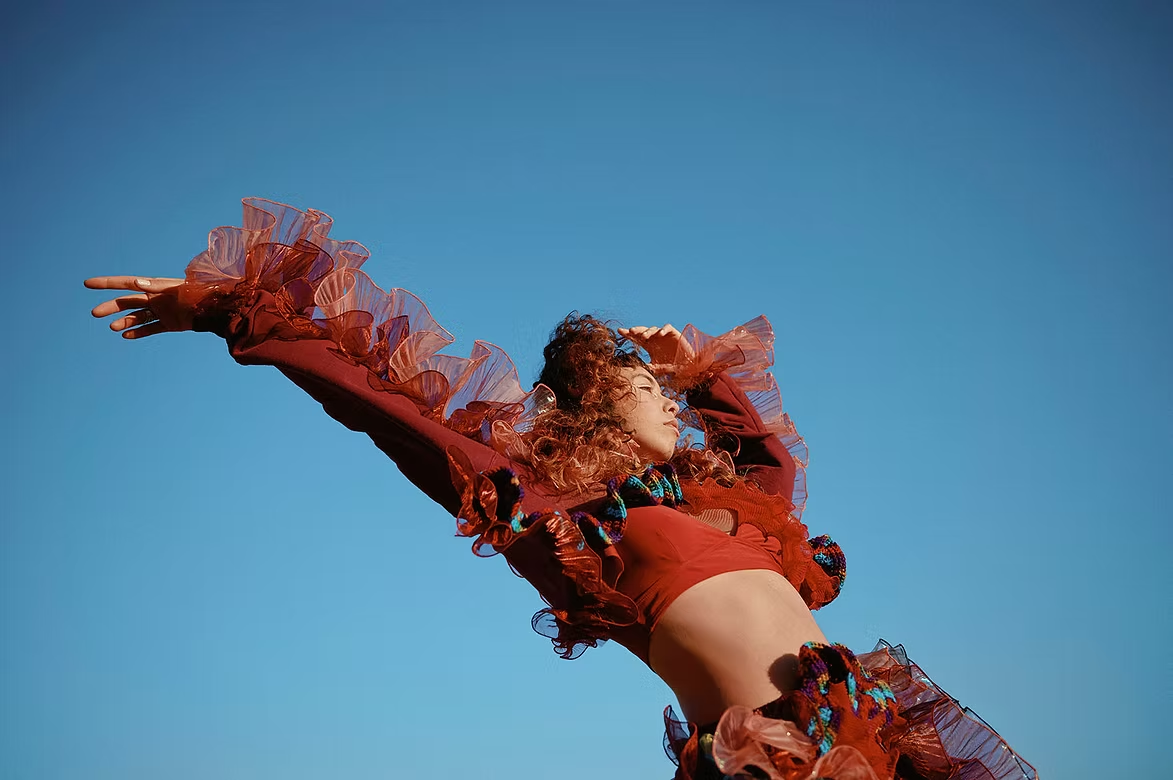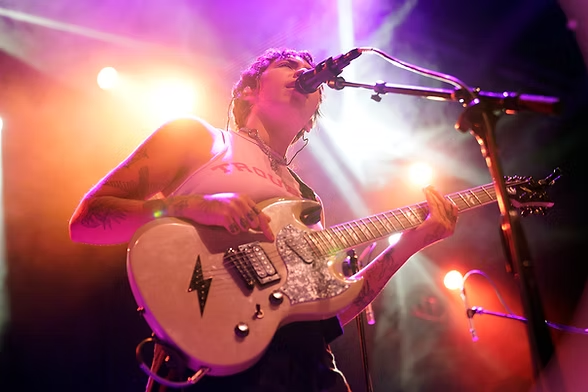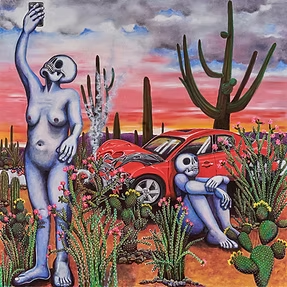
Story: Lauren Textor
Feature Photo: Angella Choe
A twenty-something misfit’s indie-rock metamorphosis
Indigo De Souza’s August 18 performance at The Midland Theatre in Kansas City is simultaneously anxiety-inducing and cathartic.
The 26-year-old American-Brazilian indie-rock artist wears flowy pants that resemble an acid-washed pickle. Her voice is uneven, as it is on many of the tracks of her three albums. It rises and falls with raw emotion, sharpening into screams during “Always” from her April release, All of This Will End.
“Father, I thought you’d be here,” she cried. “I thought you’d try. I thought you’d stay.”
In her opening act for Sylvan Esso, she runs almost straight through the set without speaking except for a few quiet “thank yous” to the audience for attending. The performance feels like you’re watching her process her grief and trauma in real-time.
In our phone interview, she explains the mental toll that touring takes on her.

De Souza at the Pageant opening for Sylvan Esso. Photo: Cory Weaver

“I’m excited to see places that I haven’t seen, but touring is really hard for me because of my brain illnesses,” De Souza said. “I have a hard time being in an unstable environment and going from place to place. But there is so much importance in my learning how to sustain myself within it because I love the impact that it has. I love being in the room with people who care about the music I make, because those people are normally healing something within themselves, too. I like creating and growing that community. Doing support tours is interesting because most people don’t know who you are when you go onto the stage. It feels like a mission to grow the community further, whereas my own shows feel like I’m meeting with the community that I already have.”
Sustaining oneself through tough times has become one of the central themes of De Souza’s music, and she finds her resilience in creating art and submerging herself in the natural world.
De Souza lives in a renovated church in a small town outside Asheville, N.C. When she’s not on tour, she devotes her time to exploring nearby creeks and forests with her friends and her dog.
“My dog is a really insane guy and he doesn’t do well in society,” she laughed. “I basically never take him anywhere where he would have to be civilized. He only goes to ferally run around with his friends in the woods, so I have to do that a lot with him because it’s the only way he gets out his energy.”
But you get the sense that De Souza also belongs to the woods. She’s spoken extensively in other interviews about her experiences in taking magic mushrooms (including during the shooting for her self-directed music video, “Younger & Dumber”) and swimming in rivers. She’s anchored herself in her environment through psychedelics and forest bathing, and it comes through in her music.
“I have a community there,” she said. “I have a lot of friends and a really, really special community that I put so much of my time and soul into. It feels like a forever family that I could not possibly leave. I’ve committed myself to the nature there, and the trees and the water and the mushrooms. I am growing to know all of it so well that it would feel strange to go somewhere else.”
In her song “The Water,” she sings about leaving her clothes on a rock while she goes for a swim. Most of the song is built around a simple refrain: “I really love the water.”
As with much of her music, the focus is on the emotion in her voice rather than lyrical complexity. With her third album, All of This Will End, De Souza comes firmly into her own by releasing a flood of memories and emotions, whether joyful or agonizing. She solidifies her artistic direction as an up-and-coming indie rocker by taking control of her image. This is especially evident in her music videos, many of which are self-directed.
“Younger & Dumber” is one of her most striking due to the elaborate costuming and set. It’s interspersed with home video clips of De Souza throughout her childhood—as a chubby-cheeked baby with tufts of dark hair, then a smiling child in a pink dress and tiara, then a little girl with pigtails stretching down her back.
She sweeps her wrists, arms and legs in fluid motions as raindrops pour down on her costume of ruffled sleeves and chaps. She wears a white and pink patterned mask with white braids attached to the scalp but removes it to wipe her hands over her face before the video closes.
“When I was first designing [the costume], I was thinking about the leafy seadragon,” she said. “They have a bunch of flaps that come off of them, and there’s one that’s especially iridescent. It changes in the light, so I looked for fabric that did that. I was inspired by rave culture’s shapes and how the chaps are used. I wanted the costume to move when I moved. Then you have the mask, which is made by Henry Shearon in Raleigh, the brother of one of my friends. While we were working on the costume, I happened to see one of his masks on Instagram, and I fell in love with it. I actually didn’t even have plans to wear a mask until I saw it on Instagram, and it changed everything.”
De Souza’s mother, Kimberly Oberhammer, designed the artwork for all three of her albums and assisted with the creation of the costume and set. In fact, one of the most telling details of their relationship is that De Souza named her debut album, I Love My Mom.
“She makes art all the time in kind of a manic way,” De Souza said. “Anytime I’m able to collaborate with her, I always jump at the opportunity because it brings us closer, but she also knows how to make anything.”
Perhaps the biggest change in De Souza’s life from her debut album to her most current release is the community that she surrounds herself with.
“When I was younger, I used to only hang out with people who made music, and then I ended up feeling really depressed,” she said. “It was like, Everyone’s so sad and writing sad songs around me. Now I feel like my community is this vibrant group of people who all need different things and have different ideas and dress in different ways. It seems like a group of misfits— it feels like all of us got bullied in school, but we ended up together and we can do great things together.”
